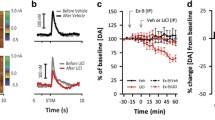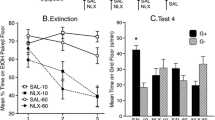Abstract
Rationale and objective
Effects on the extinction of GABAergic drug, chlordiazepoxide (CDP), and glutamatergic drug, d-cycloserine (DCS), in C57BL/6 mice were compared.
Materials and methods
Following a palatability test (Experiment 1), Experiments 2–6 involved food-reinforced lever press training followed by extinction sessions at 1- or 4-day intervals. The effects of drugs were examined. Experiment 7 involved a two-lever task.
Results
CDP did not affect food palatability (Experiment 1), but facilitated extinction when administered prior to extinction sessions via intracerebral (Experiment 2) or peripheral administration at 1-day (Experiments 3–7) or 4-day intervals (Experiment 6). Reducing the amount of training prior to extinction reduced the delay in the effect of CDP typically seen, and CDP had a larger effect in early sessions on mice that had received less training (Experiment 3). There was some evidence that CDP could be blocked by flumazenil (Experiment 4), and CDP withdrawal reversed extinction facilitation (Experiments 5 and 7). With 4-day intervals, DCS administered immediately following extinction sessions, or pre-session CDP, facilitated extinction with 48-trial sessions (experiment 6B). With six-trial sessions, the co-administration of post-session DCS enhanced facilitation produced by pre-session CDP (experiment 6A). Finally, CDP facilitated extinction in a dose-related fashion following training on a two-lever food-reinforced task (Experiment 7).
Conclusions
The findings are consistent with the hypotheses that two neurotransmitter systems have different roles in operant extinction and that glutamatergic systems are involved in extinction learning and GABAergic systems involved in the expression of that learning. This parallels findings with extinction following Pavlovian conditioning, which has been more extensively investigated.






Similar content being viewed by others
References
Amsel A (1962) Frustrative nonreward in partial reinforcement and discrimination learning: some recent history and a theoretical extension. Psychol Rev 69:306–328
Balleine BW, Ball J, Dickinson A (1994) Benzodiazepine-induced outcome revaluation and the motivational control in instrumental action in rats. Behav Neurosci 108:573–589
Berridge KC, Pecina S (1995) Benzodiazepines, appetite, and taste palatability. Neurosci Biobehav Rev Rev 19:121–131
Botreau F, Paolone G, Stewart J (2006) d-Cycloserine facilitates extinction of a cocaine-induced conditioned place preference. Behav Brain Res 172:173–178
Caldwell ML, Leslie JC (2011). Effects of chlordiazepoxide on drug discrimination training and extinction in C57Bl/6 mice. Paper presented at the Fifth Annual Conference, Division of Behaviour Analysis, Psychological Society of Ireland, Dublin, April
Cooper SJ (1980) Benzodiazepines as appetite-enhancing compounds. Appetite 1:7–19
Cooper SJ, Estall LB (1985) Behavioural pharmacology of food, water and salt intake in relation to drug actions at benzodiazepine receptors. Neurosci Biobehav Rev 9:5–19
Davis M, Ressler K, Rothbaum BO, Richardson R (2006) Effects of d-cycloserine on extinction: translation from preclinical to clinical work. Biol Psychiatry 60:369–375
De Wit H, Stewart J (1981) Reinstatement of cocaine-reinforced responding in the rat. Psychopharmacology 75:134–143
Dillon GM, Qu X, Marcus JN, Dodart J-C (2008) Excitotoxic lesions restricted to the dorsal CA1 field of the hippocampus impair spatial memory and extinction learning in C57Bl/6 mice. Neurobiol Learn Mem 90:426–433
Emmanouil D, Johnson CH, Quock RM (1994) Nitrous oxide anxiolytic effect in mice in the elevated plus-maze-mediation by benzodiazepine receptors. Psychopharmacology 115:167–172
Franklin BJK, Paxinos G (2007) The mouse brain in stereotaxic coordinates. Elsevier, Amsterdam
Joel D, Doljansky J (2003) Selective alleviation of compulsive lever-pressing in rats by D-1, but not D-2, blockade: possible implications for the involvement of D-1 receptors in obsessive-compulsive disorder. Neuropsychopharmacology 28:77–85
Keller FS, Schoenfeld WN (1950) Principles of psychology. Appleton, New York
Ledgerwood L, Richardson R, Cranney J (2003) Effects of d-cycloserine on extinction of conditioned freezing. Behav Neurosci 117:341–349
Leslie JC, Shaw D, McCabe C, Reynolds DS, Dawson GR (2004) Effects of drugs that potentiate GABA on extinction of positively-reinforced operant behaviour. Neurosci Biobehav Rev 28:229–238
Leslie JC, Shaw D, Gregg G, McCormick N, Reynolds DS, Dawson GR (2005) Effects of reinforcement schedule on facilitation of operant extinction by chlordiazepoxide. J Exp Anal Behav 84:327–238
Leslie JC, Sharp K, Quigley L, Carson A, McGovern S, Shaw D (2007) Effects of chlordiazepoxide on extinction of operant behaviour in mice vary with time of administration and rate of extinction. Eur J Behav Anal 8:257–266
Mathiasen L, Mizra NR (2005) A comparison of bretazenil, L838,417 and zolpidem in a validated mouse Vogel conflict test. Psychopharmacology 182:475–484
McCabe C, Shaw D, Atack JR, Street LJ, Wafford KA, Dawson GR et al (2004) Subtype-selective GABAergic drugs facilitate extinction of mouse operant behavior. Neuropharmacology 46:171–178
McKernan RM, Rosahl TW, Reynolds DS, Sur C, Wafford A, Atack JR et al (2000) Sedative but not anxiolytic properties of benzodiazepines are mediated by the GABAA receptor a subtype. Nat Neurosci 3:587–592
Myers KM, Davis M (2002) Behavioral and neural analysis of extinction. Neuron 36:567–584
Nevin JA, Mandell C, Atak JR (1983) The analysis of behavioral momentum. J Exp Anal Behav 39:49–59
Norwood K, McGovern SFJ, Kennedy PJ, Shaw D, Leslie JC (2011) Effects of chlordiazepoxide on runway behaviours of C57Bl/6 mice under continuous or partial reinforcement. Behav Pharmacol 22:167–172
Paolone G, Botreau F, Stewart J (2009) The facilitative effects of d-cycloserine on extinction of a cocaine-induced conditioned place preference can be long lasting and resistant to reinstatement. Psychopharmacology 202:403–409
Parnas AS, Weber M, Richardson R (2005) Effects of multiple exposures to d-cycloserine on extinction of conditioned fear in rats. Neurobiol Learn Mem 83:224–231
Pitman RK (1989) Animal models of compulsive behavior. Biol Psychiatry 26:189–198
Poling A, Byrne T, Christian L, Lesage MG (2000) Effects of cocaine and morphine under mixed-ratio schedules of food delivery: support for a behavioral momentum analysis. Pharmacol Biochem Behav 66:313–321
Quartermain D, Mower J, Rafferty MF, Herting RL, Lanthorn TH (1994) Acute but not chronic activation of the NMDA-coupled glycine receptor with d-cycloserine facilitates learning and retention. Eur J Pharmacol 257:7–12
Quirk GJ, Mueller D (2008) Neural mechanisms of extinction learning and retrieval. Neuropsychopharmacology 33:56–72
Shaw D, Dawson GR, Reynolds DS, McCabe C, Leslie JC (2004) Effects of chlordiazepoxide on extinction and re-acquisition of operant behavior in mice. Behav Pharmacol 15:225–232
Shaw D, Norwood K, Sharp K, Quigley L, McGovern S, Leslie JC (2009) Facilitation of extinction of operant behaviour in mice by d-cycloserine. Psychopharmacology 202:397–402
Sidman M (1960) Tactics of scientific research. Basic Books, New York
Skinner BF (1938) The behavior of organisms. Apple-Century-Crofts, New York
Stephens DN, Elliman TD, Dunworth SJ (2000) State-dependent behavioural sensitization: evidence from a chlordiazepoxide state. Behav Pharmacol 11:161–167
Thanos PK, Subrize M, Lui W, Puca Z, Ananth M, Michaelides M, Wang GJ, Volkow ND (2011) d-Cycloserine facilitates extinction of cocaine self-administration in c57 mice. Synapse 65:1099–1105
Walker DL, Ressler KJ, Lu KT, Davis M (2002) Facilitation of conditioned fear extinction by systemic administration or intra-amygdala infusions of d-cycloserine as assessed with fear-potentiated startle in rats. J Neurosci 22:2343–2351
Williams JH, Gray JA, Sinden J, Buckland C, Rawlins JNP (1990) Effects of GABAergic drugs, fornicotomy, hippocampectomy and septal lesions on the extinction of a discrete-trial fixed ratio 5 lever-press response. Behav Brain Res 41:129–150
Willner PJ, Crowe R (1977) Effect of chlordiazepoxide on the partial reinforcement extinction effect. Pharmacol Biochem Behav 7:479–482
Wise RA, Dawson V (1974) Diazepam-induced eating and lever pressing for food in sated rats. J Comp Physiol Psychol 86:930–941
Acknowledgements
This research was supported in part by a grant from the U.K. Biotechnology and Biological Sciences Research Council. Experimental procedures were in accordance with the UK Animals (Scientific Procedures) Act (1986) and its associated guidelines. We are indebted to two anonymous reviewers for helpful comments on an earlier draft.
Disclosure/conflicts of interest
This research was supported, in part, by a grant from the U.K. Biotechnology and Biological Sciences Research Council. The authors have no financial relationship with the U.K. Biotechnology and Biological Sciences Research Council.
Author information
Authors and Affiliations
Corresponding author
Rights and permissions
About this article
Cite this article
Leslie, J.C., Norwood, K., Kennedy, P.J. et al. Facilitation of extinction of operant behaviour in C57Bl/6 mice by chlordiazepoxide and d-cycloserine. Psychopharmacology 223, 223–235 (2012). https://doi.org/10.1007/s00213-012-2710-4
Received:
Accepted:
Published:
Issue Date:
DOI: https://doi.org/10.1007/s00213-012-2710-4




